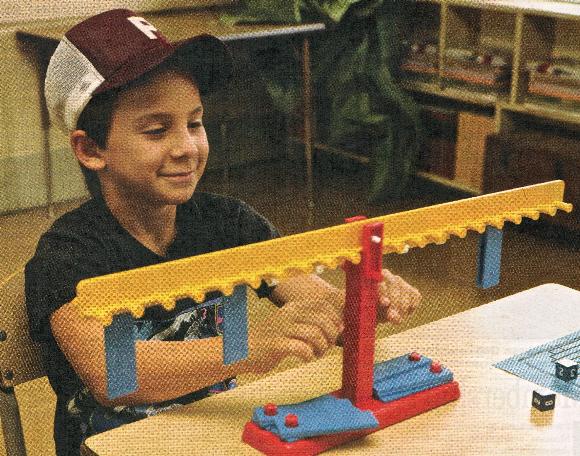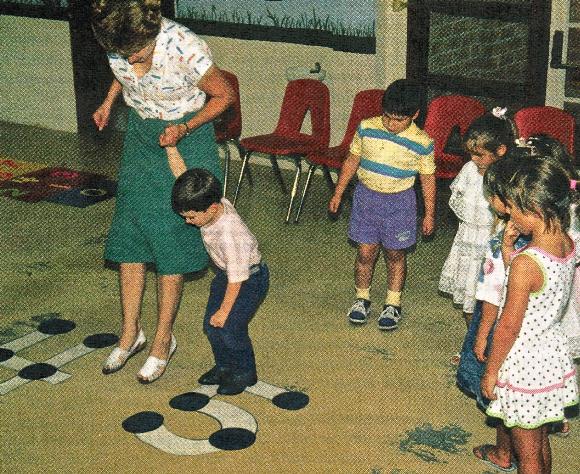
for the double-dot numerals 6-9], the children also have to “know how to count forward to 18, how to count backward from 18, and how to skip count [by 2s, 3s, 4s, …, and 10s to the decades, for example, 2, 4, 6, …, 20 for the 2s; 3, 6, 9, …, 30 for the 3s; 4, 8, 12, …, 40 for the 4s; and 10, 20, 30, …, 100 for the 10s].” With that information understood and learned, even kindergarten kids are “70 percent to 80 percent of the way home free on the 390 basic math facts.” This, says Shoecraft, removes a major barrier to kids’ success in math.”
When memory fails
The key to success is giving kids enough information to let them figure out math problems by themselves. Memorization—the mainstay of current elementary math instruction—can only go so far and favors those children who happen to have good memories. Shoecraft’s ap-proach favors everyone.
For example, young children have difficulty grasping the concept of what a number is. Their developmentally immature minds can only grasp numbers up to 7. Therefore, explains Shoecraft, if you put 10 objects together and ask children to count them, they will count 10. If you then spread the objects apart and ask them to count them again, they’ll count 10 again. But if you ask them which is the larger group, they will tell you that the spread apart group is larger.
Piaget was the one who discovered this inability to grasp, or “conserve,” large numbers, a fact that is all but ignored in the traditional elementary math curriculum. It is the natural limitation that forces children to rely on memorization instead of deductive skills to learn math. Shoecraft gets around the barrier with a game called “Fairlands,” which puts children in a world of numbers that includes “Two Land” and “Three Land” (i.e., the base 2 and base 3 systems), instead of in the abstract [Ten Land or] base-10 system.
Through Fairlands, children learn to add and subtract by borrowing and carrying. At the end of their first year, all the children are able to add ten 10-digit numbers. They also are able to understand mathematical concepts that their traditionally educated brothers and sisters have learned by rote.
You never really know how tight your shoes are until you wear a bigger size. The new shoes feel so good that you wonder why you didn’t make the change sooner.
That’s what Move It! math, a professional development program in math instruction that places understanding before procedure, is like. It feels right—for the kids who are now really understanding, learning and remembering the ideas and processes of mathematics and for the teachers who, having been frustrated with a bad fit for too long, are finding math a joy to teach.
University of Houston – Victoria associate professor Paul Shoecraft (“Dr. Paul” to his students) … has searched for 20 years for the right fit. Through research, experimen-tation and pure success, he has put together Move It! math, a reformed math instruction program for K-6 teachers and students that allows first graders and even kindergartners to understand addition and subtraction in less that a year. Shoecraft’s program, in essence, com-presses into a few months what normally takes years of traditional math instruction.
In regular math programs, says AFT associate member Shoecraft, we focus on getting kids to memorize. “Until those kids have memorized the basic [all 390 number] facts, they can’t do” addition and subtraction and basic arithmetic. “Monster” addition, subtraction, multiplica-tion and division (which involves calculations in the millions) and mastery of fractions, decimals and percents can all be wrapped up by the fourth grade in the Move It! math program, says Shoecraft. “We can do it if we start back in kindergarten and do it gracefully, in a fun, entertaining way. And the kids love it.
“By grade four, we’ve completed what is now called K through 8 math or at least K through 7,” says Shoecraft. “We’ve bought two and a half years from the standard curriculum. Middle school math will have to become something entirely different.”
Using a system that gives kids power over numbers, namely touch math, or as Shoecraft calls it, the “tap and tally” system, children are able to count and understand what they are doing, as opposed to merely memorizing by rote. Touch Math provides kids with an imaginary system of dots superimposed over the Arabic numerals.
“Our kids only have to learn four things with tap and tally,” says Shoecraft while sitting at a local Hallettsville, Texas, barbecue house where On Campus finally caught up with him for an interview. After learning where the “touch points” are on numbers one through nine, which takes about an hour [two weeks] for kindergartners [one week for the single-dot numerals 1-5 and one week xxxxxxxxxx
MAKING MATH FUN: How a Texas professor is turning math instruction on its head
On Campus, American Federation of Teachers/AFL-CIO, Vol. 10, No. 2, October, 1990



A six-year-old works with the balance beam to learn about elements of algebra.
One rule of thumb for Paul Shoecraft is to use manipulatives, such as a balance beam, to immerse young students in math.
Gonzales teacher Lynn Gescheidle has a group of pre-kindergarten students hop their way through a touch-count exercise. Teachers reinforce the application of the learning technique in a variety of settings.
Next > | New Math Formula | Kindermath | Demonstration | Federal Funding | Inservice Funded | Anyone Can Learn Math | Summer Volunteers | Monster Math | Making Math Fun | Area Leaders | New Math of 90s | Video | MOVE IT! | Math Made Easy | VIPS to View Pgm | Gov. Richards | Richard's Attention | Revolution | Adds Up | Mexico | Letter | Atlanta 2003 | < Back — HOME


